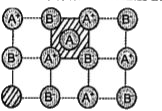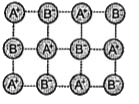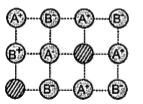Most crystals show good cleavage because their atoms ions or molecules are
weakly bonded together
strongly bonded together
spherically symmetrical
arranged in planes
The correct Answer is:D
To answer the question "Most crystals show good cleavage because their atoms, ions, or molecules are...", we can break down the explanation into a step-by-step solution.
1. Understanding Types of Solids:
- Solids can be classified into two main categories: crystalline solids and amorphous solids. Crystalline solids have a well-defined geometric structure, while amorphous solids lack this order.
2. Defining Crystalline Solids:
- Crystalline solids are characterized by their orderly arrangement of atoms, ions, or molecules. This arrangement allows them to be cut cleanly along specific planes.
3. Cleavage in Crystalline Solids:
- The term "cleavage" refers to the tendency of a crystal to split along specific planes. This occurs because the atoms, ions, or molecules in crystalline solids are arranged in layers or sheets that are stacked on top of each other.
4. Example of Cleavage:
- For instance, when a crystal of sodium chloride (NaCl) is cut, it breaks along the planes where the ionic bonds are weaker, resulting in smooth, flat surfaces. This is due to the regular arrangement of Na+ and Cl- ions in the crystal lattice.
5. Comparison with Amorphous Solids:
- In contrast, amorphous solids, such as glass, do not have a regular arrangement of particles. When they are broken, they do not cleave along defined planes, resulting in irregular and jagged surfaces.
6. Conclusion:
- Therefore, the reason most crystals show good cleavage is that their atoms, ions, or molecules are arranged in planes, allowing them to break cleanly along these planes.
Final Answer:
Most crystals show good cleavage because their atoms, ions, or molecules are arranged in planes.
---
- Solids can be classified into two main categories: crystalline solids and amorphous solids. Crystalline solids have a well-defined geometric structure, while amorphous solids lack this order.
- Crystalline solids are characterized by their orderly arrangement of atoms, ions, or molecules. This arrangement allows them to be cut cleanly along specific planes.
- The term "cleavage" refers to the tendency of a crystal to split along specific planes. This occurs because the atoms, ions, or molecules in crystalline solids are arranged in layers or sheets that are stacked on top of each other.
- For instance, when a crystal of sodium chloride (NaCl) is cut, it breaks along the planes where the ionic bonds are weaker, resulting in smooth, flat surfaces. This is due to the regular arrangement of Na+ and Cl- ions in the crystal lattice.
- In contrast, amorphous solids, such as glass, do not have a regular arrangement of particles. When they are broken, they do not cleave along defined planes, resulting in irregular and jagged surfaces.
- Therefore, the reason most crystals show good cleavage is that their atoms, ions, or molecules are arranged in planes, allowing them to break cleanly along these planes.
Most crystals show good cleavage because their atoms, ions, or molecules are arranged in planes.
Similar Questions
Knowledge Check
- Question 1 - Select One
Why does H+ ion always get associated with atoms or molecules ?
AIonisation enthalpy of hydrogen resembles that of alkali metals.BIts reactivity is similar to halogens.CIt resembles both alkali metals and halogens.DLoss of an electron from hydrogen atom results in a nucleus of very small size as compared to other atoms or ions. Due to small size it cannot exist free. - Question 2 - Select One
In a crystal, the atoms are located at the position of:
AMaximum potential energyBMinimum potential energyCZero Potential energyDInfinite potential energy - Question 3 - Select One
The crystal showing Frenkel defect is:
A B
B C
C D
D
Ca is the good reducing agent, because
View SolutionA zwitter ion is a molecule containing
View SolutionWhy does H+ ion always get associated with atoms or molecules ?
View SolutionIn a crystal, the atoms are located at the position of
View SolutionCrystals show colour due to the presence of:
View Solution

